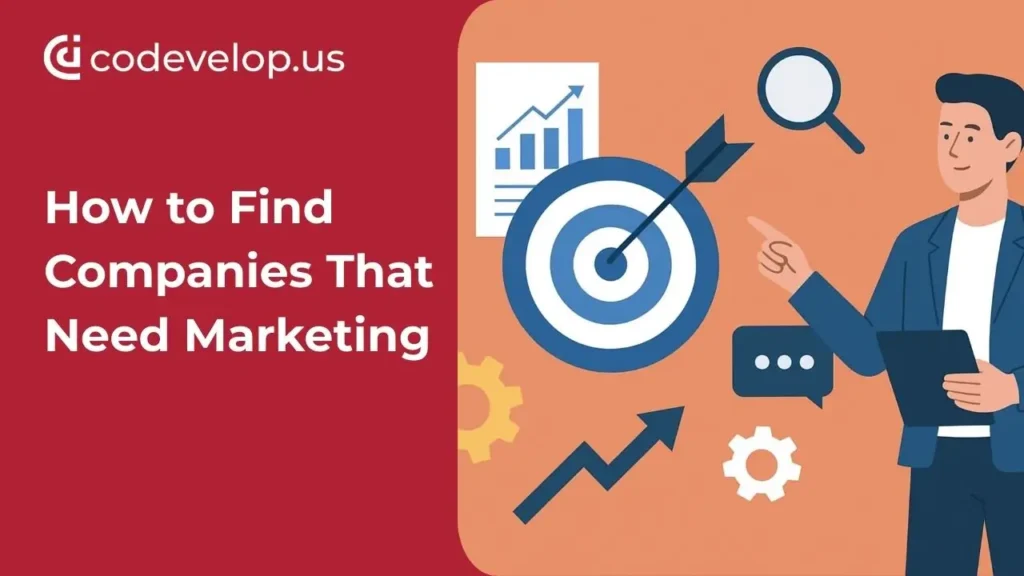You can tell when a business needs marketing the way you can tell when a restaurant needs a new menu: the signs are right there. Stale website. Silent social feeds. Ads that look like they were designed in 2013. Phones are not ringing like they used to. If you know where to look—and how to approach—finding companies that want help isn’t that hard. Here’s how I do it (and how you can, too).
Start with the obvious signals.
Walk down any Main Street or scroll through any local search result, and you’ll spot them.
- The site looks fine on desktop, but breaks on a phone.
- Last Instagram post was six months ago… announcing “big things coming.”
- Google Business Profile has mismatched hours, a few photos, and one lonely review.
- Paid ads are running to a generic homepage instead of a landing page.
None of these is fatal on its own. Together they say, “We’re busy, we’re understaffed, and we could use a hand.” That’s your opening.
Go where growth is already happening.
Companies that are expanding usually need marketing yesterday. Look for:
- New locations: franchise announcements, “now open” posts, local press blurbs.
- Hiring spurts: they’re posting for sales reps, SDRs, or a junior marketer—often a sign the founder wants a pipeline.
- Fresh funding: startups with new capital are under pressure to grow. They rarely have a full team in place.
You can find these with simple tools: LinkedIn searches (“hiring marketing” + your city), local business journals, startup newsletters, community Slack groups, and even chamber-of-commerce emails. No fancy software required.
Use maps like a bloodhound.
Pick a niche (dentists, remodelers, med spas, specialty e-comm) and open Google Maps. Zoom into a city, then a neighborhood. Click through listings:
- Is the website modern and fast on mobile?
- Are there recent photos, Q&As, and responses to reviews?
- Do the services, pricing, and booking flow make sense?
Make a short list of five businesses per neighborhood that are “almost there.” Not broken—just under-optimized. Those are the easiest wins.
Borrow audiences instead of cold-calling the world
Some people already serve your ideal clients: accountants, web designers, CRMs, POS vendors, printers, niche SaaS tools, and even local videographers. They hear the same complaint you do—“we need more leads”—and they’d love a reliable partner to refer.
Offer to co-host a 30-minute Zoom mini-workshop for their clients (“How to fix your Google profile in 10 minutes”). Give value, no pitch. You’ll leave with two or three warm intros every time.
Make a tiny promise—and keep it fast.
Most owners aren’t buying “strategy.” They’re buying relief. Lead with a small, concrete fix:
- “Your Google Business Profile is missing three categories; I can tune that and add fresh photos this week.”
- “Your top ad is sending traffic to the homepage—give me two days and I’ll build a simple landing page that converts better.”
- “You’re ranking #6 for ‘roof repair in ___’; I can move that up with on-page tweaks and a better internal link from your service area page.”
Charge for it (even a modest fee). Deliver in days, not weeks. When the needle moves, the bigger retainer conversation is easy.
Write outreach that sounds like a human, not a brochure
Keep it short, specific, and local. Something like:
Subject: quick fix I spotted on your ___ page
Hey [Name] — I live in [city] and noticed your [service] page is missing a call-to-action on mobile, so people have to scroll a lot before they can book.
I help [niche] fix little leaks like that. If you want, I can send a 3-minute Loom showing exactly what I’d change and why. No strings.
— [You]
[site] • [phone]
No jargon. No “synergies.” Offer something useful right away.
Build a tiny case study library (two is enough)
You don’t need a glossy PDF. Two punchy stories beat ten vague slides:
- “Med spa in Phoenix: fixed their GBP, added service photos, swapped ‘call us’ for ‘book now’ → 28% more calls in 30 days.”
- “Roofing contractor: moved ad traffic to a one-page estimate form, cut cost per lead from $180 to $92 in two weeks.”
A screenshot and three sentences. That’s it. Prospects want proof, not poetry.
Fish where intent is high
A few spots where buyers go when they’re already ready:
- Job boards: Companies looking for a part-time marketing hire will often consider an outside pro if you show them a faster path.
- Niche directories: industry associations, SaaS partner pages, local vendor lists—offer a member perk (audit, training, discounted setup).
- Community posts: neighborhood groups, professional Facebook groups, subreddits—answer questions well, and people DM you.
Show up consistently for a month and you’ll feel the difference.
Price like you’ll see them again
Simple menu. Clear boundaries. Think:
- Starter fix (one-time): profile cleanup, landing page, analytics setup.
- Core monthly: content + local SEO + review flow, or ads + landing pages.
- Growth sprint (6–8 weeks): one goal, one KPI, intense focus (e.g., “book 50 more consults before spring”).
Don’t sell “everything.” Sell the next outcome.
Keep score in public (lightly)
Post small wins on LinkedIn or your site: a before/after screenshot, a line about what changed, a takeaway. Not boastful—helpful. People remember the person who shows their work.
When a prospect says “not now”
No problem. Put them on a short nurture list:
- A quarterly local trend note (“These three searches exploded in [city] last season”).
- A one-page checklist before their busy season.
- A quick benchmark (“Most [niche] we audit are missing ____; here’s the 5-minute fix.”)
Stay useful. When the pain spikes, you’re the first call.
A mini playbook you can run this week
- Pick one niche and one metro area.
- Build a list of 25 businesses using Maps + common-sense checks.
- Record five Looms (2–3 minutes each), pointing out a fix.
- Send ten short emails with one Loom and one sentence about a small paid starter.
- Ask two adjacent vendors to co-host a micro-workshop next month.
- Deliver one small win fast. Turn it into a tiny case study. Repeat.
You don’t need a giant pipeline. You need momentum and a few good fits.
The truth most folks won’t say out loud: companies don’t “buy marketing.” They buy outcomes, delivered by people they trust. If you show them something broken, fix a piece quickly, and keep your promises, you will never be short on companies that need you—especially here in the States, where competition is loud and results speak the loudest.
Looking to attract clients who truly need your marketing expertise? 🚀 Codevelop helps agencies and freelancers find the right-fit businesses, build trust fast, and scale with confidence. Start today with Codevelop.


